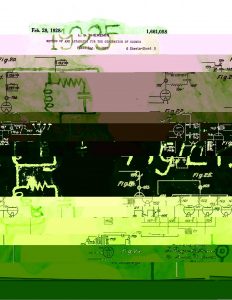I have been playing theremin for a little less than a year. The instrument has quickly become a passion for me. As a composer, it is desirable for me to be able to publicly perform some of my own works. Thus, the challenge is to write a piece for an entry level performer that is still going to engage an audience sufficiently.
Setting the piece at a slow tempo allows the theremin to focus on slow lyrical lines that are within my grasp as a performer. The fixed audio part, created using Apple’s Logic Pro, serves as a compliment to the slow, lyrical nature of the theremin. The fixed audio uses faster, often syncopated rhythms that add a surface level energy to the piece.
Another way to add energy and excitement to the piece is to add a visually engaging video to accompany the work. The concept behind the work attempts to bridge the visual and audio worlds. In the visual realm, pantone refers to a color classification system. In sound, I offer pantone as a description of an instrument, like the theremin, that can create any frequency that exists between its highest and lowest possible notes.
Creating a video for Pantone creates another set of problems, related to my relative inexperience as a visual artist. Years ago I wrote a chamber opera, Into the Cautious Season, that used projected images that were similar in nature to a graphic novel representation of the plot and libretto to both set the scene, as well as to display the libretto. I created the graphic novel version in black and white as well as a version using some color. Inspired by the water color skies used in It’s the Great Pumpkin Charlie Brown, I used watercolor paints on the black and white images to create a limited color version.
Due to my lack of skill as a visual artist, I cannot say that the graphic novel version of Into the Cautious Season was successful. However, I can say that it was good enough to be a proof of concept, and that I believe a version done by someone with decent illustration skills could work well. Moreover, I began to think that simple scans of single color fields of watercolor paint could make an interesting basis for a video.
For Pantone I started with nine black and white images from the patent drawings for the theremin. Then, I used watercolors to paint single color designs that mimic the designs on top of the drawings. After scanning the images into a computer, I then made nine glitched versions of each, by changing each image file to a text file, copying, pasting, and deleting material before changing the file back into image files.
For each musical phrase of Pantone I superimposed nine of these glitched images on top of each other in Apple’s Final Cut Pro. I set each layer to zoom in and out and to move about independently of the other images. Furthermore, each layer was set to only let a percentage of colors through. This approach resulted in a detailed, yet slow moving texture of colors. One final detail added to the video involved adding an increasing number of visual accents that coincide with musical accents. These were achieved by exporting specific frames as images, glitching those image files, and superimposing them for about four frames over the video.
Sonically speaking Pantone is an homage to the future of my youth. When I was a child, commercially available analog synthesizers were relatively new. Artists like Wendy Carlos, Don Dorsey, Jean-Jacques Perry, and Isao Tomita created sonic palettes that will always sound like the future to me. In creating the fixed audio accompaniment for the piece, I emphasized timbres that emulated these analog synthesizers.
Ultimately I believe that Pantone offers several features that can engage listeners: lyrical melodic material performed on a novel instrument, a fixed audio part that is rhythmically energetic, a sonic palette that invokes a nostalgic science-fictionesque world, and a colorfully meditative visual component filled with detail.
(in performance in Pawtucket, RI on December 4th, 2016)
(in performance in Bridgewater, MA on March 1st, 2017)



